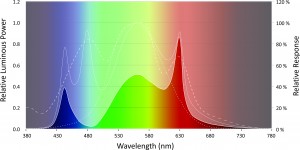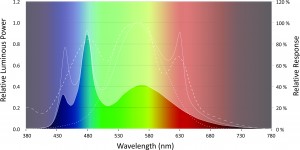
In order to understand poultry lighting, you must understand both poultry vision and the nature of the lighting being used. This scientific article walks you through the subject matter taking a bird’s eye view of how today’s lighting systems (including sunlight, incandescent, fluorescent, high-pressure sodium and LEDs) interact with how poultry see to produce varying results.
For the complete discussion view the pdf.
Here are some important out-takes:
Light source selection plays a very important role for poultry growers. As far back as 1987, the Wall Street Journal reported that chickens raised under full-spectrum lighting lived twice as long, laid more eggs, and were less aggressive than chickens raised under fluorescent lighting. Eggs were also larger and had stronger shells. What they may not have recognized then is the vast difference in color between the two sources.
Since that time, researchers have continued to study the effects of color – but not without controversy. Often the conclusions of their work is inconsistent or even contradictory. The main reason is the differences in the methodology. Each study involves an exponential number of variables. These include bird breed, barn differences (size, reflectivity, ceiling height, noise), climate and environment, seasonality, day periods of natural light, human interaction, light schedule, light source, intensity, color, light uniformity, health of flock, type and quality of electrical controls, and many other factors not easily documented or even recognized.
The entire scientific community agrees on basic physiological effects of light. (a) Light facilitates sight which is a necessity for food search; (b) Light entrains the circadian cycle; (c) Light initiates and regulates the release of multiple hormones which are essential in metabolic regulation, reproduction and bone formation. The fact is that birds, poultry included, can perceive light in different, non-pictorial ways. This makes selection of the light source even more important.
There are three key photosensitive areas: (1) Retina – In the retina, photons are absorbed in by photo-pigments rhodopsin (rods), iodopsin (cones) and recently discovered (1998) melanopsin. (2) Pineal Gland – Photon absorption is achieved by functional photoreceptors located in the pineal gland on the top of the brain. (3) Hypothalamus – Recently discovered photon absorption by deep encephalic photoreceptors. For retinal reception, light enters the retina directly; however, in the hypothalamus and the pineal gland, light must first penetrate the avian skull. The avian skull, skin, and brain tissue create a natural light filter. Due to the presence of blood (hemoglobin) in these tissues, red light penetrates the skull with the highest transmission efficiencies while blue green light is blocked almost completely. With this in mind, we offer summations of what we believe to be reasonably well-documented findings. Even so, it is very important for poultry producers to learn as much as they can about light sources and light color, intensity, and schedules. We also encourage them to keep accurate records to assist in ongoing learning.

One of the main functions of red light is Melatonin regulation and stimulation of reproductive activity. Red spectrum of the light is the only spectrum which entrains hypothalamic and pineal oscillators. The rhythm of melatonin synthesis is driven both by an extrapineal and an intrapineal oscillator entrained by light and dark information, which is perceived directly and indirectly by the pineal gland. Melatonin enhances the immune response and counteracts immunodeficiency states resulting from acute stress, viral diseases, aging, or drug treatment. The hypothalamus is the reproductive controller of the hen.
Contrary to what is believed, recognition of day length does not involve the eyes. The light response involves the stimulation of hypothalamic photosensitive cells by receiving light energy at photostimulation. That means that light intensity and spectrum must be adequate to have the light energy penetrate the feathers, the skin, the skull and the brain tissue.
Light stimulation of the hypothalamus results in the secretion of Gonadotropin Releasing Hormone (GnRH). When activated by GnRH, the anterior pituitary secretes two gonadotropin hormones, Follicle-Stimulating Hormone (FSH) and Luteinizing Hormone (LH). FSH acts on sperm-producing structures in the testes, while LH acts on the interstitial cells of the testes causing them to secrete the steroid hormone testosterone. LH is essential for sexual maturation and for daily egg production to occur and is an integral component of the day-to-day events of ovulation.
There is a widely held belief now supported by research that red light increases the growth rate of chickens and turkeys when it’s provided at the beginning of the rearing period. This is due to the fact that red light stimulates locomotion activity and the ability of adolecsent birds to more easily find and consume food. The increase in activity helps minimize leg disorders in the late rearing period.
There is also evidence indicating that actual feed consumption per egg laid is reduced under red lighting, particularly with wavelength above 640nm resulting in no difference in egg size, shell weight and thickness, or yolk and albumen weights. This suggests that light with a peak around 640nm, with the intensity reduced to the minimum required for egg laying, can reduce feed intake and reduce energy costs. Other research indicates very narrow wavelength red light may help in manipulating the size of eggs, if the operation intends to provide smaller eggs.

Consistently, research concludes monochromatic LED source lighting increases growth in broilers reared under green monochromatic light during the early stage by enhancing proliferation of skeletal muscle satellite cells. Blue light has also been shown to be helpful in the growth and sexual development of poultry at a later age by elevation of plasma androgens. Combined green and blue light promotes myofiber growth due to more effective stimulation of testosterone secretion.
There is industry wide consensus that monochromatic blue light has a calming effect on animals which is particularly useful during semen collection from male turkeys. Other studies show exposure to blue light causes a decrease in blood pressure and positively effects blood glucose levels and triglyceride levels. One of the most evident drawbacks of incandescent and high pressure sodium lamps is a lack of blue spectrum essential for stimulating melanopsin, a photopigment found in specialized photosensitive ganglion cells of the retina that are involved in the regulation of circadian rhythms. With incandescent light, overall intensities must be extremely high to achieve blue levels sufficient to reset circadian cycles.
It is proposed that the circadian pacemaker consists of two component oscillators. One is entrained to dusk and controls the onset of melatonin secretion. The second is entrained to dawn and controls the melatonin amplitude. The natural daylight spectrum during sunsets and sunrises is different from natural light at noon. There are also significant seasonal variances in the spectral composition of sunset and sunrise light. It is proposed that birds react not only to seasonal changes in daylength, but also seasonal changes in the light spectrum. These facts add to the importance of considering spectrum in the addition of sunrise/sunset controls in artificial lighting choices. The second picture on your right illustrates the typical spectrum of a summer sunset.